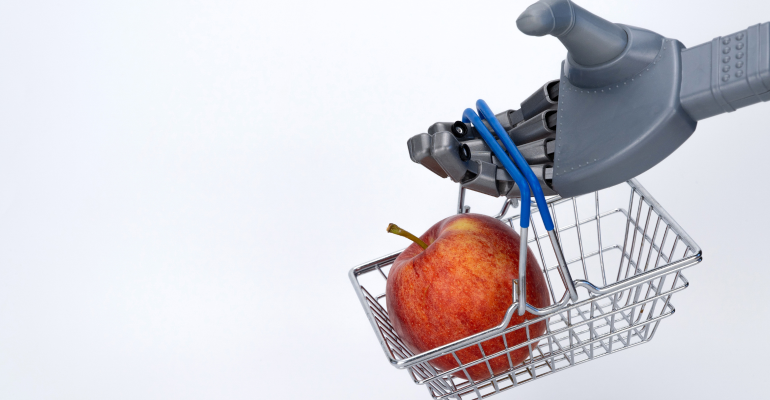 Adam Gurga is national manager of grocery and retail partnerships with Cimcorp, a pioneer of intralogistics automation, specialized in fresh food handling and tire-handling solutions.
Adam Gurga is national manager of grocery and retail partnerships with Cimcorp, a pioneer of intralogistics automation, specialized in fresh food handling and tire-handling solutions.
It’s safe to say that the last few years have been filled with big challenges for businesses across the grocery industry.
On top of rising costs and growing inflation, grocery retailers have dealt with major supply chain disruptions—from supply issues to shipping delays to labor shortages. Warehouses and distribution centers have struggled to keep products moving and store shelves stocked with a consistent supply of fresh goods. This has left grocers with spoiled products, empty store shelves, and lost sales.
Now, produce distributors and grocery retailers are exploring new tools to bolster distribution operations, reduce costs, and keep customer satisfaction up. One area where we’re seeing rising investments is automation.
Here are four key automation trends to look for:
1. Speeding up fresh produce distribution
The grocery industry is not new to warehouse automation, but most investments have focused on handling shelf stable goods. Previous generations of robotic systems just weren’t built for handling fresh produce. Older systems typically managed product storage and picking as two separate functions—a setup that’s far too slow for produce, since fulfillment speed directly impacts quality and freshness. That’s why produce handling has remained a manual process and is usually the least efficient area of any warehouse.
Today, grocery retailers are starting to take advantage of a new breed of automation. Ideal for fresh food distribution, these solutions combine buffer storage and order picking into one seamless system that performs order fulfillment tasks with high speed and accuracy. Products can enter the facility and be picked immediately, meaning fresh produce spends less time in the warehouse and gets to store shelves faster than ever before.
Thanks to their investments in automation, some grocery retailers are already delivering fresh produce from farm-to-shelf in less than 24 hours.
2. Overcoming labor issues
Fresh food handling is tough, labor-intensive work where throughput and efficiency are low. Produce arrives from suppliers in flimsy, unstable packaging that’s difficult to handle. Employees repeatedly travel up and down aisles, move products in and out of storage, and pick orders by hand. And they do it all in chilly, cumbersome conditions.
Given the nature of the work, warehouses struggle to hire staff and experience constant turnover. Many new hires stay just a few months at max, and then employers are back to square one with hiring, training, and all the associated costs.
To alleviate the strain, grocery retailers are turning to automation. Robotic solutions can take over repetitive, labor-intensive order fulfillment tasks—running around the clock with minimal human involvement.
As automation takes on the heavy lifting, better job opportunities will open up for existing employees. Rather than doing strenuous work in harsh conditions, workers can fill more engaging roles like operating, maintaining, and supervising the robotic systems. These tech-focused roles may even attract the younger generation of jobseekers who want to work with advanced robotics and software.
3. Getting creative about costs
Capital is tight, interest rates are up, and companies are hesitant to fund large-scale automation projects or new construction builds. So, grocery retailers are getting creative with their approach to automation. Some are exploring options like Robotics-as-a-Service (RaaS), where they rent the technology and pay as they go. But since RaaS is a fairly new offering, the long-term benefits remain to be seen.
For businesses that want a more reliable way to keep costs down and generate ROI, a great option is modular, scalable automation. Modular systems are built using pre-engineered, standardized cells of automation. The modules can be arranged to fit any facility footprint, installed quickly, and then built up gradually—like building blocks. Grocers can first introduce automation where it will make the biggest impact, then expand their implementation as business grows.
A modular system with a gantry design will further reduce costs. In this setup, produce is housed in uniform plastic crates, stacked securely on the warehouse floor in high-density storage areas. Gantry robots quickly and easily access any SKU from overhead. The need for expensive racking or shelving systems is eliminated, and it’s also much easier to clear the area for routine sanitation.
4. Supporting sustainability
Today’s consumers are more environmentally conscious than ever. To compete in the years to come, grocery retailers need to prioritize sustainability. And what’s good for the environment is also good for business. Studies have shown that consumers are willing to pay more to support grocery retailers whose stance on sustainability aligns with their own.
Automation can help grocers further their commitment to sustainability in multiple ways. For example, rapid, accurate order fulfillment—only possible through automation—reduces food waste at the retail and consumer levels. Produce will be optimally fresh when it reaches stores, then will last much longer in consumers’ homes after purchase.
Preparing for anything ahead
While the future is always uncertain, one thing is clear: The grocery industry will be led by those who invest in innovative technology to stay competitive. And though every grocery business is unique, the right automated solution can satisfy any fresh food distribution needs—today, tomorrow, and long into the future.





